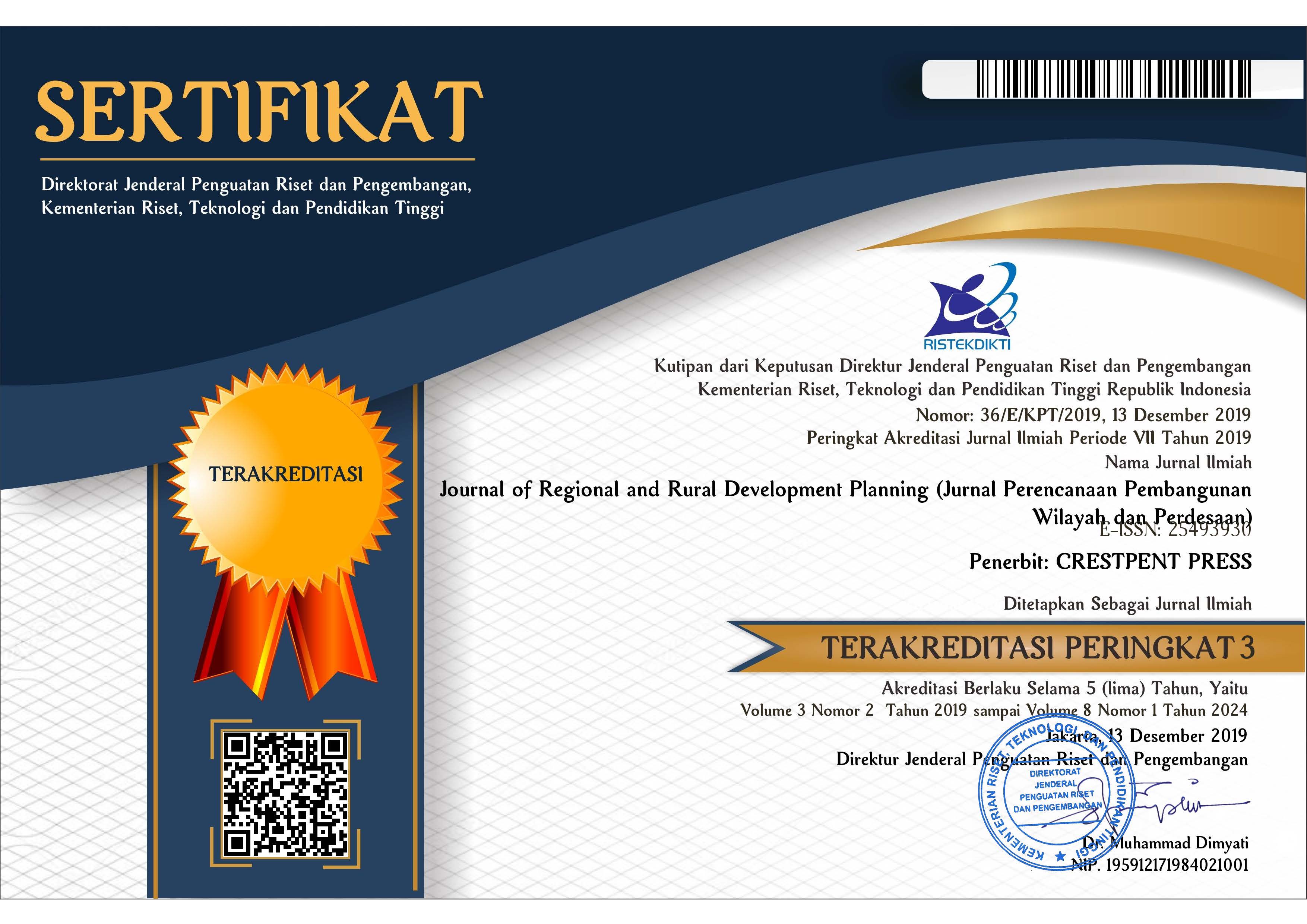Pola Sebaran dan Keterpusatan Fasilitas Pendidikan sebagai Pelayanan Publik di Kota Pontianak
Abstract
In accordance with the objectives of the Pontianak City Spatial Plan, the development orientation is emphasized in the trade and services sector. In terms of essential services, Educational facilities are means to develop human resources. Along with population growth, Educational facilities and their distribution need to be improved. This article aims to examine the distribution and centralization of Educational facilities as an evaluation for the arrangement of the distribution of services. Besides, it can be a case study for other cities in managing the distribution of facilities. The distribution of access and Educational facilities is assessed through network analysis consisting of calculations of degree, closeness, betweenness, and eigenvector. From the results obtained, South Pontianak District and East Pontianak District are the areas with the highest or largest scores, especially in measuring closeness, betweenness, and eigenvector. It is indicated that the two districts tend to be the most central areas. Meanwhile, for the superimposition between access and distribution of facilities, it is found that Higher Education facilities tend to be facilities with a "centralized" position in the network configuration. In addition, elementary schools were also found
to be the most accessible in each area or district.
References
Adriyanto, R, E., & Hariyanto. (2019). Evaluasi Pola Sebaran Spasial dan Kualitas Pelayanan Terhadap Efektivitas Samsat Keliling di Kabupaten Kendal. Geo Image (Spatial-Ecological-Regional)., 8 (2), 124–133.
Albrechts, L., & Mandelbaum, S, J. (2005). The Network Society, A New Context for Planning? Routledge, New York and London
Badescu, S., Branea, A. M., Gaman, M. S. (2016). The Importance of The Public Facilities Network Within the Urban Environment and Its Distribution Within Collective Housing Neighborhoods. Case Study: Timisoara, Romania. Sgem 2016, Bk 4: Arts, Performing Arts, Architecture and Design Conference Proceedings, Vol III, August 24-30. Bulgaria
Borgatti, S, P. (1995). Centrality and AIDS. Connections., 18 (1), 112-115.
Borgatti, S, P., Everett, M, G., & Johnson, J, C. (2013). Analyzing Social Networks (first edition). Sage Publications.
Hanneman, R, A., & Riddle, M. (2005). Introduction to social network methods. Riverside, CA: University of California, Riverside. http://faculty.ucr.edu/~hanneman/ [October 2021]
Hardiyansyah. (2018). Kualitas Pelayanan Publik. Konsep, Dimensi, Indikator, dan Pelayanannya. Yogyakarta: Penerbit Gava Media.
Jahan, S., & Oda, T. (1996). Distribution of Public Facilities in Dhaka, Bangladesh: A Spatial Analysis. The Bangladesh Urban Studies. Retrieved from http://www2.kobe-u.ac.jp/~oda/Jahan&Oda.pdf [October 2021]
Kementerian Agraria dan Tata Ruang/BPN RI. (n.d.). Rencana Tata Ruang Kementerian Agraria dan Tata Ruang/Badan Pertanahan Nasional. https://gistaru.atrbpn.go.id/rtronline/ [October 2021]
Maryam, N, S. (2016). Mewujudkan Good Governance Melalui Pelayanan Publik. Jurnal Ilmu Politik Dan Komunikasi.,Volume Vi No. 1/Juni 2016.
Ni, J., Qian, T., Xi, C., Rui, Y., & Wang, J. (2016). Spatial distribution characteristics of healthcare facilities in Nanjing: Network point pattern analysis and correlation analysis. International Journal of Environmental Research and
Public Health., 13 (8). Pavlovich, K. (2003). The Evolution and Transformation of a Tourism Destination Network: The Waitomo Caves, New Zealand. Tourism Management 24, 203-206.
Pemerintah Kota Pontianak. (2013). Peraturan Daerah Kota Pontianak Nomor 2 Tahun 2013 Tentang RTRW Kota Pontianak Tahun 2013-2033.
Pemerintah Provinsi Kalimantan Barat. (n.d.). Geoportal Pemerintah Provinsi Kalimantan Barat. http://geospasial.kalbarprov.go.id/jelajah.html [October 2021]
Puspitasari, N. L. P., & Bendesa, I. K. G. (2016). Analisis Kualitas Pelayanan Publik di Badan Pelayanan Perijinan Terpadu Kabupaten Badung. E-Jurnal Ekonomi Dan Bisnis Universitas Udayana., 5 (1), 1–114.
Putra, M, P. (2020) Mengenal Pelayanan Publik; Ombudsman RI. Artikel Ombudsman. https://ombudsman.go.id/artikel/r/artikel--mengenal-pelayanan-publik [October 2021] Rinaldi, R. (2012). Analisis Kualitas Pelayanan Publik. Jurnal Administrasi Publik: Public Administration Journal., 2 (1), 22-34.
Sanni, L. (2010). Distribution Pattern of Healthcare Facilities in Osun State, Nigeria. Ethiopian Journal of Environmental Studies and Management., 3 (2), 65-76. https://doi.org/10.4314/ejesm.v3i2.59839
Scott, N., Baggio, R., & Cooper, C. (2008). Network Analysis and Tourism: From Theory to Practice. Channel View Publications. UK, US, Canada.
Teri., Mariana, D. (2019). Skor Pelayanan Publik Pontianak Capai 98,6%. Hi Pontianak. https://kumparan.com/hipontianak/skor-pelayanan-publik-pontianak-capai-98-6-1s7HeDqlw8n/full [October 2021]
Umar, A. A., Adepoju, M. O., Adesina, E. A., & Bamgbose, M. O. (2015). Optimal Location Determination of Some Public Facilities within Minna Metropolis: A Geospatial Technique Approach. Journal of Geographic Information System, 07 (06), 658–666. https://doi.org/10.4236/jgis.2015.76053
Umar, J., & Bolanle, W. (2015). Locational Distribution of Health Care Facilities in the Rural Area of Ondo State. British Journal of Education, Society & Behavioural Science., 11 (1), 1–8.
Wasserman, S., & Faust, K. (1994). Social Network Analysis: Methods and Applications. Cambridge University Press.
Zhao, M., Xu, G., & Li, Y. (2016). Evaluating urban public facilities of Shenzhen by application of open-source data. Geo-Spatial Information Science., 19 (2), 129–139.
Copyright (c) 2022 Journal of Regional and Rural Development Planning (Jurnal Perencanaan Pembangunan Wilayah dan Perdesaan)

This work is licensed under a Creative Commons Attribution-ShareAlike 4.0 International License.




.png)














